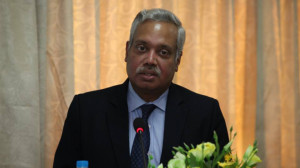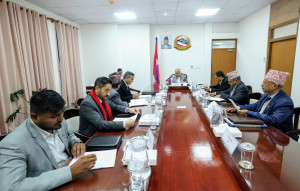National
Cyber abuse cases targeting children jump from 176 to 706 in three years
Nepal Police data show an eight-fold surge in cybercrime cases in five years as of last year.
Post Report
Cybercrimes targeting children in Nepal are rising sharply, driven in part by artificial intelligence and the growing digital footprint of young users.
Data from the Nepal Police Cyber Bureau shows an eight-fold surge in cybercrime cases in five years as of last year. In the fiscal year 2019-20, 2,301 complaints were filed. That number shot up to 19,730 in the fiscal year 2023-24.
As of Thursday, with just two weeks remaining in the fiscal year, 17,546 cybercrime cases have already been recorded.
Amid this, cases involving minors are particularly concerning. In fiscal year 2022-2023, only 176 cases of cyber violence targeting children were reported—46 involving boys and 130 involving girls.
That number jumped to 635 in 2023-24, with 253 boys and 382 girls affected.
In the ongoing fiscal year, the tally has already reached 706, including 321 boys and 385 girls.
In just three years, reported incidents have quadrupled. Based on the current year’s data, Nepal is witnessing nearly two cases of cyber violence against children every day.
According to the bureau, children are being exposed to online sexual abuse, grooming, photo mutilation, revenge porn, hacking and impersonation of social media accounts, and unsolicited messages containing explicit images or links.
With the rise of AI tools, photo manipulation and mutilation cases have become the most common form of cybercrime among all age groups, including children.
Looking at the data, while girls remain disproportionately targeted, the rise in boy victims signals that cyber threats are expanding in both scope and scale.
Anil Raghuvanshi, founder and president of ChildSafeNet, says the vulnerability of boys in these cases is often underestimated.
“In our research of cyberviolence like online intimate partner violence, we found that boys are equally vulnerable,” he said. “In cases involving online child sexual abuse materials, perpetrators don’t discriminate. They extort and blackmail girls, boys, older and younger individuals alike.”
He pointed out that many boys fall victim due to curiosity and a lack of awareness. According to him, sometimes, men pretending to be women coax them into sending nude pictures.
Young boys, driven by curiosity and the desire to explore romantic relationships online, often fall easily for such manipulative tactics.
These are later used for blackmail and extortion.
Raghuvanshi added that some boys even share explicit images of themselves or their friends, not fully understanding the consequences, a trend that reflects both the vulnerability and recklessness that can accompany early adolescence online.
Further, the legal framework meant to protect children is outdated and weak.
A 2023 research by Voice of Children and KNH Germany involving 514 children, families and child protection and juvenile justice stakeholders points out that Nepal’s relevant cyberviolence policies are fragmented and lack a dedicated focus on OCSA prevention.
For instance, the Electronic Transaction Act of 2008, the primary legislation addressing online content in Nepal, fails to meet the demands of the digital age.
While it prohibits the dissemination of illicit content, it has serious shortcomings, including a 35-day limitation for filing complaints, inadequate privacy protections, and weak child protection measures.
Experts point out flaws in the Act Relating to Children, 2018 as well. It fails to define critical terms such as child pornography, grooming, sextortion, and cyberstalking, resulting in confusion and poor implementation, they say.
Raghuvanshi emphasises that public institutions need to evolve beyond the narrow assumption that boys are immune to sexual cyber violence and girls are the only victims.
“The protection mechanisms need to move beyond this limited notion,” he said. “Cyber violence is a child protection crisis, cutting across gender lines. Sexual and gender minorities are at particular risk and should be prioritised in response frameworks.”




 12.12°C Kathmandu
12.12°C Kathmandu














